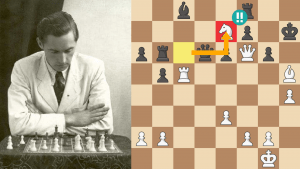
Dreams: The Secret Formula For Chess Success
In general, most players view imbalances as positional commodities. However, though that’s certainly true, one also has to learn to recognize dynamic and tactical imbalances.
To be a good player, you need to learn as many tactical and positional patterns as possible -– time and experience allow you to painlessly put more and more of these patterns in your memory bank. However, like everything else in life, if you want to go to higher levels of understanding, hard work has to be a part of the process.
But we’re still missing something. Knowing patterns isn’t enough. You also have to train yourself to spot those imbalances. Simply put: if you don’t see them, you won’t be able to use them.
This “searching for patterns” is useful for players of all ratings. Some will only be able to spot dynamic patterns, like the enemy king in the center, which should instantly make your lizard brain flash “kill, kill, kill!”
Others will notice the possibility of acquiring more space, or creating holes in the enemy camp, or any number of other things.
And once again, we’re missing something: dreams/imagination/willpower!

While searching for patterns (which will eventually be almost instantaneous), and then actually noticing the possibility of creating a positive pattern, you will often find that you can’t find a way to make it a reality, or make use of it. When that happens, you need to “insist” that there must be a way and then allow yourself to dream or imagine a path that will take you to the promised land.
This doesn’t mean you’ll always succeed, but you’ll succeed far more than you usually do.
This sounds really advanced (or insane!?), and it certainly can be. But everyone will be able to make use of this to some extent –- the strong players will find complex dreams, while those that are starting out will find things appropriate for their level.
This new series is all about dreams (okay, it’s also about imbalances and patterns), and it’s presented in a question and answer format. Some will be hard, some will be very basic, but all of them should prove instructive once you do your best to solve the puzzles and then carefully read the prose in the answers.

CHESS DREAMS
No, we’re not talking about a chess dream where you dominate the world of chess with your immaculate skills. The chess dream I’m talking about is:
A) You break down the nuts and bolts of the position (imbalances, dynamics, tactics, pawn structures, etc.) in front of you as best you can (more concepts than moves!).
B) Then you imagine (the dream!) the ideal position based on your earlier breakdown. NO move-by-move analysis!
I expect you to do this with ALL the puzzles.
PUZZLES
Puzzle One:
Spend some time on this position and try and find sanity in the apparent chaos.
Puzzle Two:
Based on this pawn structure, what are the usual plans for both sides? Does White’s f4-f5 change those plans?
Here’s the position after 13.f5:
ANSWERS
Puzzle One, Answer:
Puzzle Two, Answer One:
In general, White will strive to make use of his queenside pawn majority (a2, b2, c2, d5) by expanding in that sector. For example: a2-a4-a5 followed by c2-c4 and, eventually, b2-b4.
Black will try and get his own majority moving (...f7-f5), or he might capture on f4 at the right time and stick his knight on the nice e5-square, or (after taking on f4) try and get some play down the e-file. I should add that if White doesn’t play correctly on the queenside, a counter blow in that area (e.g., a well-timed ...b7-b5) could leave White’s pawn majority in tatters.
Of course, though taking on f4 gives Black the e5-square, it also gives White the d4-square, so lots of care from both sides is needed.
All that is fine and dandy, but 13.f5 dramatically changes the position!
Puzzle Two, Answer Two:
If you thought that f4-f5 was the prelude to a kingside attack, you’re wrong. The advance of the f-pawn to f5 stopped Black from playing ...f7-f5. By doing so, White created a lovely central square (e4!) that can’t be touched by Black’s pawns.
After 13.f5, White’s dream is swap off his dark-squared bishop for Black’s knight and, ideally, also swap the light-squared bishops. Then, once White’s knight lands on e4, it will dominate the board.
I removed the queens and rooks so you can marvel at the power of White’s e4-knight.
Okay, let’s return to the position after 13.f5. White’s dream is a worthy one but, though it might have succeeded against a weaker opponent, Areshhenko was fully aware of White’s dream and didn’t allow it to happen!
Dreams don’t always come true, but in chess dreams give you a kind of “distant vision” that defies calculation. Remember: patterns are the first road signs which show you the way. Breaking down the position’s particular imbalances gives you an even more expansive understanding of the position’s soul. And dreams, bolstered by patterns and imbalances, take you even further to fanciful plans that can’t be created by more normal mental processes.
Then, once you’ve merged the patterns, imbalances, and dreams, it’s time for calculation. And, if calculation tells you that the dream’s road is safe to tread, then the sky is the limit.
RELATED STUDY MATERIAL
- Read IM Silman's previous article: Mastering Squares, Part 7.
- Watch FM Mike Klein's video: 12 Nakamura Wins In 20 Minutes.
- Take a lesson on planning in the Chess Mentor.
- Solve some puzzles in the Tactics Trainer.
- Looking for articles with deeper analysis? Try our magazine: The Master's Bulletin.






